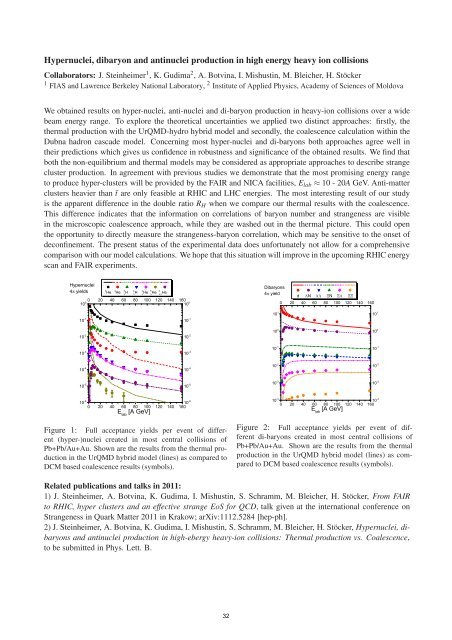FIAS Scientific Report 2011 - Frankfurt Institute for Advanced Studies ...
FIAS Scientific Report 2011 - Frankfurt Institute for Advanced Studies ...
FIAS Scientific Report 2011 - Frankfurt Institute for Advanced Studies ...
Create successful ePaper yourself
Turn your PDF publications into a flip-book with our unique Google optimized e-Paper software.
Hypernuclei, dibaryon and antinuclei production in high energy heavy ion collisions<br />
Collaborators: J. Steinheimer 1 , K. Gudima 2 , A. Botvina, I. Mishustin, M. Bleicher, H. Stöcker<br />
1 <strong>FIAS</strong> and Lawrence Berkeley National Laboratory, 2 <strong>Institute</strong> of Applied Physics, Academy of Sciences of Moldova<br />
We obtained results on hyper-nuclei, anti-nuclei and di-baryon production in heavy-ion collisions over a wide<br />
beam energy range. To explore the theoretical uncertainties we applied two distinct approaches: firstly, the<br />
thermal production with the UrQMD-hydro hybrid model and secondly, the coalescence calculation within the<br />
Dubna hadron cascade model. Concerning most hyper-nuclei and di-baryons both approaches agree well in<br />
their predictions which gives us confidence in robustness and significance of the obtained results. We find that<br />
both the non-equilibrium and thermal models may be considered as appropriate approaches to describe strange<br />
cluster production. In agreement with previous studies we demonstrate that the most promising energy range<br />
to produce hyper-clusters will be provided by the FAIR and NICA facilities, Elab ≈ 10 - 20A GeV. Anti-matter<br />
clusters heavier than ¯t are only feasible at RHIC and LHC energies. The most interesting result of our study<br />
is the apparent difference in the double ratio RH when we compare our thermal results with the coalescence.<br />
This difference indicates that the in<strong>for</strong>mation on correlations of baryon number and strangeness are visible<br />
in the microscopic coalescence approach, while they are washed out in the thermal picture. This could open<br />
the opportunity to directly measure the strangeness-baryon correlation, which may be sensitive to the onset of<br />
deconfinement. The present status of the experimental data does un<strong>for</strong>tunately not allow <strong>for</strong> a comprehensive<br />
comparison with our model calculations. We hope that this situation will improve in the upcoming RHIC energy<br />
scan and FAIR experiments.<br />
�����������<br />
� �������<br />
�<br />
� �� �� �� �� ��� ��� ��� ���<br />
� ��<br />
�� ��<br />
�� ��<br />
�� ��<br />
�� ��<br />
�� ��<br />
�� ��<br />
� � � � � �<br />
� � � � � �<br />
� �<br />
������������������������� ����������� ���<br />
� �� �� �� �� ��� ��� ��� ���<br />
� ��� ��������<br />
Figure 1: Full acceptance yields per event of different<br />
(hyper-)nuclei created in most central collisions of<br />
Pb+Pb/Au+Au. Shown are the results from the thermal production<br />
in the UrQMD hybrid model (lines) as compared to<br />
DCM based coalescence results (symbols).<br />
�� �<br />
�� ��<br />
�� ��<br />
�� ��<br />
�� ��<br />
�� ��<br />
�� ��<br />
�<br />
���������<br />
� ������<br />
� �<br />
� �<br />
��������� �����<br />
� �<br />
� �<br />
��<br />
�����<br />
�<br />
�<br />
�<br />
� �� �� �� �� ��� ��� ��� ���<br />
�� �<br />
�� �<br />
�� ��<br />
�� ��<br />
�� ��<br />
�� ��<br />
� �� �� �� �� ��� ��� ��� ���<br />
� ��� ��������<br />
Figure 2: Full acceptance yields per event of different<br />
di-baryons created in most central collisions of<br />
Pb+Pb/Au+Au. Shown are the results from the thermal<br />
production in the UrQMD hybrid model (lines) as compared<br />
to DCM based coalescence results (symbols).<br />
Related publications and talks in <strong>2011</strong>:<br />
1) J. Steinheimer, A. Botvina, K. Gudima, I. Mishustin, S. Schramm, M. Bleicher, H. Stöcker, From FAIR<br />
to RHIC, hyper clusters and an effective strange EoS <strong>for</strong> QCD, talk given at the international conference on<br />
Strangeness in Quark Matter <strong>2011</strong> in Krakow; arXiv:1112.5284 [hep-ph].<br />
2) J. Steinheimer, A. Botvina, K. Gudima, I. Mishustin, S. Schramm, M. Bleicher, H. Stöcker, Hypernuclei, dibaryons<br />
and antinuclei production in high-ebergy heavy-ion collisions: Thermal production vs. Coalescence,<br />
to be submitted in Phys. Lett. B.<br />
32<br />
�� �<br />
�� �<br />
�� ��<br />
�� ��<br />
�� ��<br />
�� ��<br />
�
















